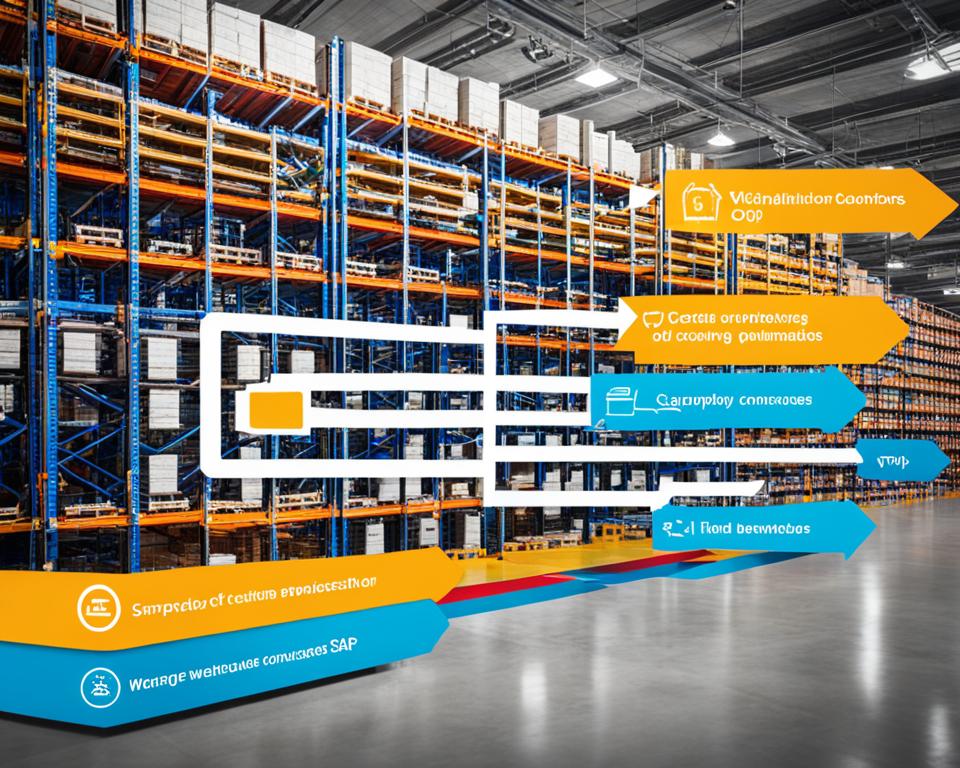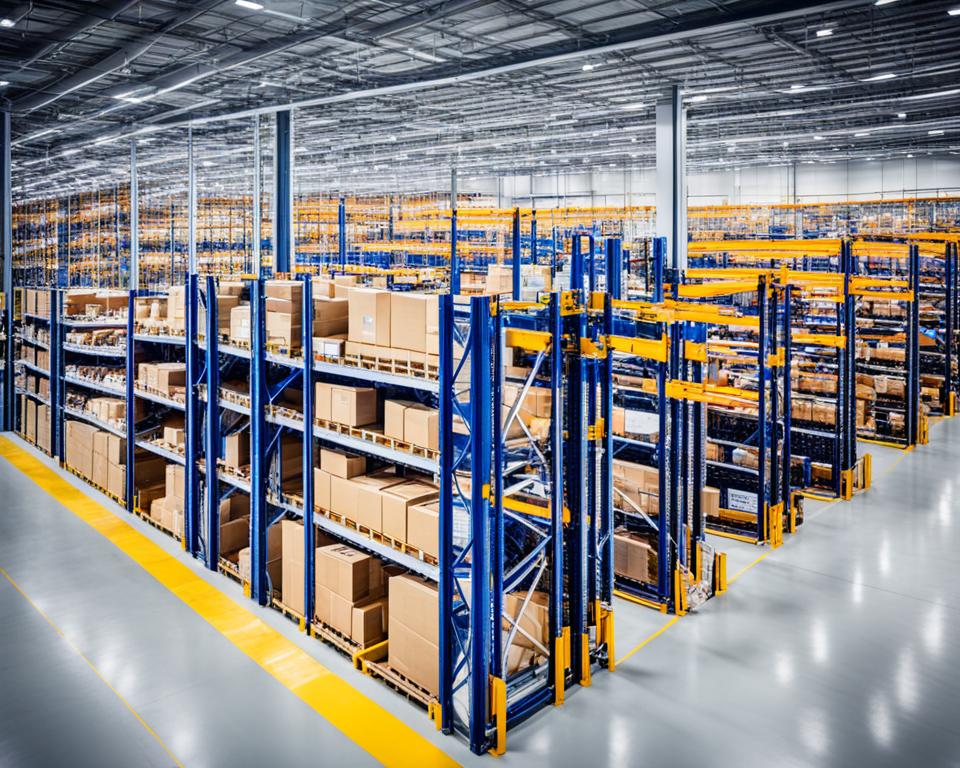Have you ever thought about how a small change in your warehouse could make a big difference? With the growing complexity of logistics, it’s key to understand how SAP WM can change your warehouse for the better. SAP WM is a powerful tool made to improve inventory management and make goods movement smoother. It’s a top pick for logistics experts like me who aim to make operations more efficient and boost productivity.
Key Takeaways
- SAP WM enhances inventory tracking through efficient data management.
- The system streamlines goods movement, reducing operational delays.
- Integration with existing logistics processes is seamless and effective.
- It provides valuable insights that help in decision-making.
- Implementing SAP WM can lead to significant cost savings over time.
- Training and support are critical for successful adoption within teams.
Introduction to Warehouse Management Systems
Warehouse Management Systems (WMS) are key for businesses to stay efficient. They help manage Inventory Control by tracking what’s in stock, where it is, and where it’s going. This ensures orders are filled on time and boosts overall performance.
A WMS does many important tasks. It gives a clear view of what’s in stock, helping with smart decisions. It also makes order processing faster by automating tasks and cutting down on mistakes. This means better stock management and faster inventory turnover.
WMS technology has grown a lot over time, thanks to Logistics Software and data analytics. Now, we have advanced, cloud-based systems that help businesses stay ahead. Using these systems, companies can meet customer needs and use resources wisely.
| Feature | Description | Benefits |
|---|---|---|
| Inventory Tracking | Real-time visibility of stock levels and locations | Reduces stock discrepancies |
| Order Fulfillment | Automated processing of orders and shipments | Increases fulfillment speed and accuracy |
| Reporting | Customizable reporting tools for performance analytics | Enhances decision-making capabilities |
| Integration | Connects with existing business systems | Streamlines overall operations |
Understanding SAP WM
SAP WM, or Warehouse Management, is key to making supply chains run smoothly. It has many parts that make operations better. It works well with other SAP modules, making it a vital part of complete solutions.
The user interface of SAP WM is easy to use, making it simple to manage warehouse tasks. Each code has a specific job, like managing stock, sending out goods, and storing materials. This makes warehouse work more efficient.
SAP WM connects different departments, keeping data accurate and improving communication. It links with SAP ERP, giving a clear view of the supply chain. This helps in making better decisions.
Using SAP WM helps me manage inventory better. Features like cycle counting and seeing stock in real-time make things more precise. An understanding of SAP WM lets me make my warehouse more efficient. This boosts the productivity of my logistics work.
Key Features of SAP WM
SAP WM offers key tools for better warehouse management. It focuses on managing inventory and moving goods efficiently. This leads to smoother workflows and fewer mistakes. Let’s explore how SAP WM helps streamline logistics.
Inventory Management Capabilities
SAP WM’s inventory management keeps track of stock levels in real-time. It helps users manage goods flow accurately. This is key to keeping inventory accurate. Key features include:
- Real-time visibility on stock levels
- Efficient tracking of goods through various processes
- Alerts for low stock levels to prevent shortages
These tools help with efficient inventory management. They work with strong SAP features for better decisions and planning.
Goods Movement Functions
Goods Movement is vital for efficient warehouses. It handles tasks like receiving, picking, packing, and shipping. These functions help businesses run better. The benefits of Goods Movement in SAP WM are:
- Simplified receiving processes with automated updates
- Optimized picking operations through accurate order management
- Streamlined packing processes that enhance shipping accuracy
Using SAP WM’s advanced features makes goods movement efficient and error-free. This supports a flexible supply chain. SAP’s focus on inventory management and goods movement shows its comprehensive warehouse management approach.
| Feature | Description | Benefits |
|---|---|---|
| Real-time Tracking | Continuous monitoring of stock levels | Improved accuracy and reduced discrepancies |
| Batch Management | Management of goods by tracking batches | Enhanced inventory control and compliance |
| Automated Updates | Instant updates for goods movement | Quicker response times and informed decision-making |
Warehouse Automation with SAP WM
SAP WM is a key player in warehouse automation. It has changed how warehouses work. With barcode scanning and RFID systems, I can make processes smoother. This leads to a big jump in efficiency.
Warehouse automation brings big benefits with SAP WM. It makes keeping track of inventory more accurate, cutting down on mistakes. This means I always know what stock I have and when I need to restock. Plus, it saves money by needing less manual work.
Automation makes picking and packing items much quicker. This is key for meeting customer needs fast.
The following table outlines the key advantages I experience from warehouse automation through SAP WM:
| Advantage | Description |
|---|---|
| Enhanced Efficiency | Automation speeds up sorting, packing, and shipping processes. |
| Cost Reduction | Decreased labor expenses through the use of automated machinery. |
| Improved Accuracy | Reduction of errors with barcode and RFID technologies. |
| Real-time Tracking | Constant updates on inventory levels and product locations. |
Using SAP WM for warehouse automation makes my operations better. It also sets me up for growth in the future.

Benefits of Using SAP WM in Logistics Processes
Using SAP WM can make logistics better in any company. It makes things run smoother and boosts warehouse management efficiency. Knowing the benefits of SAP WM is key for businesses wanting to get their logistics in top shape and keep stock well.
Enhanced Stock Keeping
SAP WM is great for keeping stock in check. It uses smart inventory management to cut down on waste and prevent too much stock. This means products are always there when customers need them, making them happier. SAP WM helps with stock keeping in big ways:
- Real-time inventory tracking
- Automated replenishment processes
- Accurate demand forecasting
Improved Warehouse Operations
SAP WM also makes warehouse work better. It helps use space well and makes workflows smoother. This means workers do less busywork and focus more on important tasks. Warehouse improvements include:
- Streamlined picking processes
- Efficient storage solutions
- Enhanced labor management
SAP WM changes how we manage stock and improves warehouse operations a lot. It leads to better customer experiences and helps businesses grow in a sustainable way.
Integrating SAP WM with Supply Chain Optimization
Integrating SAP WM with Supply Chain Optimization is key to better efficiency. This combo leads to big wins in how well the supply chain works. It helps predict demand better, making sure there’s enough stock without too much.
Working together, SAP WM and supply chain strategies make buying materials more efficient. They cut down on time and costs. Teams can make smart choices with up-to-date inventory info from SAP WM, avoiding too little or too much stock.
Stakeholders work better together thanks to this integration. SAP WM connects different departments and partners, making information flow smoothly. This leads to faster responses to changes in the market and what customers want.
- Enhanced demand forecasting for better stock management.
- Streamlined procurement processes leading to reduced costs.
- Increased collaboration across stakeholders for agile decision-making.
In conclusion, my experience shows the perks of linking SAP WM with Supply Chain Optimization. Companies see a big boost in efficiency. This puts them in a strong spot in the market.

Warehouse Analytics: Gaining Insights through SAP WM
Understanding SAP WM’s analytics is key to better warehouse operations. Warehouse Analytics is crucial for improving logistics management. It helps by tracking data in real-time, giving organizations important insights for better decisions.
Real-time Data Tracking
Real-time data tracking is essential in SAP WM Analytics. It lets companies keep an eye on inventory, track items, and check how well they’re doing. This helps make decisions based on data, leading to better inventory management and lower costs. Here are some benefits of using real-time data tracking:
- Enhanced visibility of inventory and stock levels.
- Timely detection of stock movement issues.
- Improved accuracy in meeting customer orders.
- Informed decision-making with the latest data.
Adding real-time data tracking to warehouse operations boosts customer happiness by ensuring orders are delivered on time. Here’s a comparison showing how real-time tracking affects SAP WM:
| Aspect | Without Real-time Tracking | With Real-time Tracking |
|---|---|---|
| Inventory Accuracy | Often outdated, leading to stockouts | Consistently accurate, reducing stockouts |
| Order Fulfillment Speed | Delayed due to manual checks | Immediate processing based on real-time data |
| Cost Efficiency | Higher operational costs from inefficiencies | Lower costs through streamlined processes |
| Customer Satisfaction | Increased complaints due to delays | Improved satisfaction with timely deliveries |
Best Practices for Implementing SAP WM
Implementing SAP WM needs careful planning and following best practices. It’s key to involve stakeholders early to make the transition smoother and use the system fully. Setting clear goals and timelines helps avoid issues that could stop the project. Testing the system is crucial to make sure everything works right, setting the stage for a successful launch.
Training and Support for Users
User training is crucial for SAP WM’s success. Investing in training gives employees the skills to get the most out of the system. Having ongoing support is also vital, helping users overcome challenges and improve their skills. This approach boosts warehouse efficiency and productivity.
It’s smart to use resources to improve training, like the best practices in procurement. These tips help create training that meets the company’s specific needs.

Common Challenges in Warehouse Management
Warehouse management faces many challenges that affect businesses a lot. One big issue is Warehouse Management Challenges with inventory accuracy. When the count of items doesn’t match the records, it can cause stock-outs or overstocking. This messes up the supply chain.
Order processing errors are another big problem. When orders are picked and shipped wrong, customers get unhappy and might return items. These Operational Issues hurt a company’s finances and reputation over time.
Seeing what’s happening in the warehouse can be hard. Not having real-time data makes it tough to make good decisions and react fast. Using SAP WM Solutions helps by offering tools for tracking inventory and improving workflows.
Here’s a table showing how these challenges affect businesses and how SAP WM Solutions can help:
| Challenge | Description | SAP WM Solutions |
|---|---|---|
| Inventory Accuracy | Discrepancies can lead to stock-outs or overstock situations. | Real-time tracking and automated inventory management. |
| Order Processing Errors | Inaccuracies in picking/shipping affect customer satisfaction. | Barcode scanning and verification processes. |
| Poor Operational Visibility | Limited insights lead to ineffective decision-making. | Dashboards and analytics tools for enhanced visibility. |
SAP WM: Streamline Your Warehouse Management
SAP WM is a key tool for streamlining warehouse management. It brings together many features to tackle the challenges of logistics. I’ve looked at its main benefits and how it boosts efficiency.
SAP WM helps with better inventory control and smooth goods flow. These are key for any warehouse. Using these tools, I’ve seen how companies can make their work flow better. This leads to saving time and cutting costs.
Also, SAP WM lets you analyze warehouse data to make better decisions. With real-time analytics, I can quickly spot areas to improve. This system encourages ongoing improvement, which is crucial in today’s fast-moving logistics world.
By using SAP WM, companies see big changes. These changes improve efficiency and make customers happier with faster service. This system is a complete solution for warehouse management.

Case Studies: Successful Implementations of SAP WM
Looking at Successful SAP WM Implementations shows how companies overcome challenges and get great results. These Case Studies show different ways to improve warehouse management.
A big retail chain improved its logistics with SAP WM. They cut down on how long it took to fill orders by making inventory management better. This led to a 30% increase in how well they worked and happier customers. These Real-World Examples show how custom solutions can meet specific business needs.
A leading car maker had trouble seeing what stock they had. After using SAP WM, they used data analysis to manage their inventory better. This switch helped them reduce extra stock by 25%. These results show how SAP WM can lead to success.
These Case Studies stress the need to understand SAP WM and its effects on different industries. The key to success is having good implementation plans, focusing on training users, and offering support. Developers can improve their reporting skills with tools like ABAP reporting tools, helping make warehouse operations better.
Future Trends in Warehouse Management Technology
In the fast-changing world of Warehouse Management Technology, knowing about Future Trends is key. New tech like artificial intelligence, machine learning, and robotics is changing how warehouses work. These innovations make things run smoother and work better.
AI-driven analytics is a big trend now. It helps predict demand and manage stock better. Warehouses use smart algorithms to cut down on extra stock and speed up sales. Machine learning systems get smarter over time, making quick decisions and boosting speed.
Robotics is also changing warehouse work. AGVs and robots help pick and pack orders faster and cheaper. These innovations help companies offer better service and meet customer needs in a tough market.
To keep up, companies should train their teams on these future trends. Knowing new tech not only helps employees do their jobs better. It also creates a team ready to adapt to new changes.

Adding these new tech tools helps businesses stay competitive and meet customer needs. For tips on improving coding skills for your warehouse system, check out object-oriented programming techniques.
| Trend | Description | Benefits |
|---|---|---|
| AI-Driven Analytics | Uses AI to better forecast and manage stock. | Less extra stock, faster sales. |
| Machine Learning | Systems that learn and adapt from data. | Quick decisions, faster action. |
| Robotics | Robots and AGVs for picking and packing. | Quicker order fulfillment, lower costs. |
Conclusion
In this look at SAP WM, it’s clear it boosts Warehouse Efficiency. It makes managing warehouses better by streamlining processes. This helps businesses keep track of their stock and improve their logistics.
Advanced features in SAP WM let you track things in real-time and make better decisions. These are key in today’s fast-paced world.
This article has shown why good warehouse management is crucial. It talked about how automation and smart inventory management can boost productivity a lot. Using SAP WM helps companies stay ahead by following the best practices in the field.
To get the most out of SAP WM, it needs careful setup and regular checks. For more on how SAP WM changes businesses, check out this resource on Ariba case studies. It shows how companies are changing their buying strategies for growth.
FAQ
What is SAP WM and how does it improve warehouse management?
SAP WM is a top-notch solution for better warehouse management. It makes managing inventory and moving goods faster and more efficiently. This leads to better stock keeping and smarter logistics.
What are the key features of SAP WM?
SAP WM has cool features like tracking inventory in real-time and managing batches. It also helps with receiving, picking, packing, and shipping goods. These features make operations smoother and cut down on mistakes and costs.
How does warehouse automation benefit from SAP WM?
SAP WM boosts warehouse automation with tech like barcode scanning and RFID. This makes things run faster, cuts down on labor costs, and makes sure things are done right. It lets me use these tools to make my warehouse run better.
How can I integrate SAP WM with supply chain optimization?
To link SAP WM with supply chain optimization, it’s key. It helps with forecasting demand, makes buying materials smoother, and helps everyone work together better. This leads to better efficiency and performance overall.
What are some common challenges in warehouse management?
Warehouses often face issues like keeping inventory accurate, making mistakes in orders, and not having a clear view of operations. SAP WM tackles these problems, making things run smoother, more efficiently, and with fewer mistakes.
How can I ensure a successful implementation of SAP WM?
For a successful SAP WM setup, plan your project well, get everyone on board, and test the system carefully. Also, don’t forget to train your users and keep support going to get the most out of it and make the switch smooth.
What role does warehouse analytics play in SAP WM?
Warehouse analytics in SAP WM gives us real-time data insights. This helps us make smart decisions, manage inventory better, cut costs, and make customers happier by getting their orders to them on time.
Can you share examples of successful SAP WM implementations?
Yes, many companies have made SAP WM work for them, sharing their strategies, the hurdles they faced, and the gains they saw. These stories show how SAP WM can boost warehouse operations and make logistics more efficient.
What future trends should I be aware of in warehouse management technology?
Watch out for new trends like artificial intelligence, machine learning, and robotics in warehouse tech. Knowing about these changes will help you stay ahead and keep up with the evolving world of logistics.


